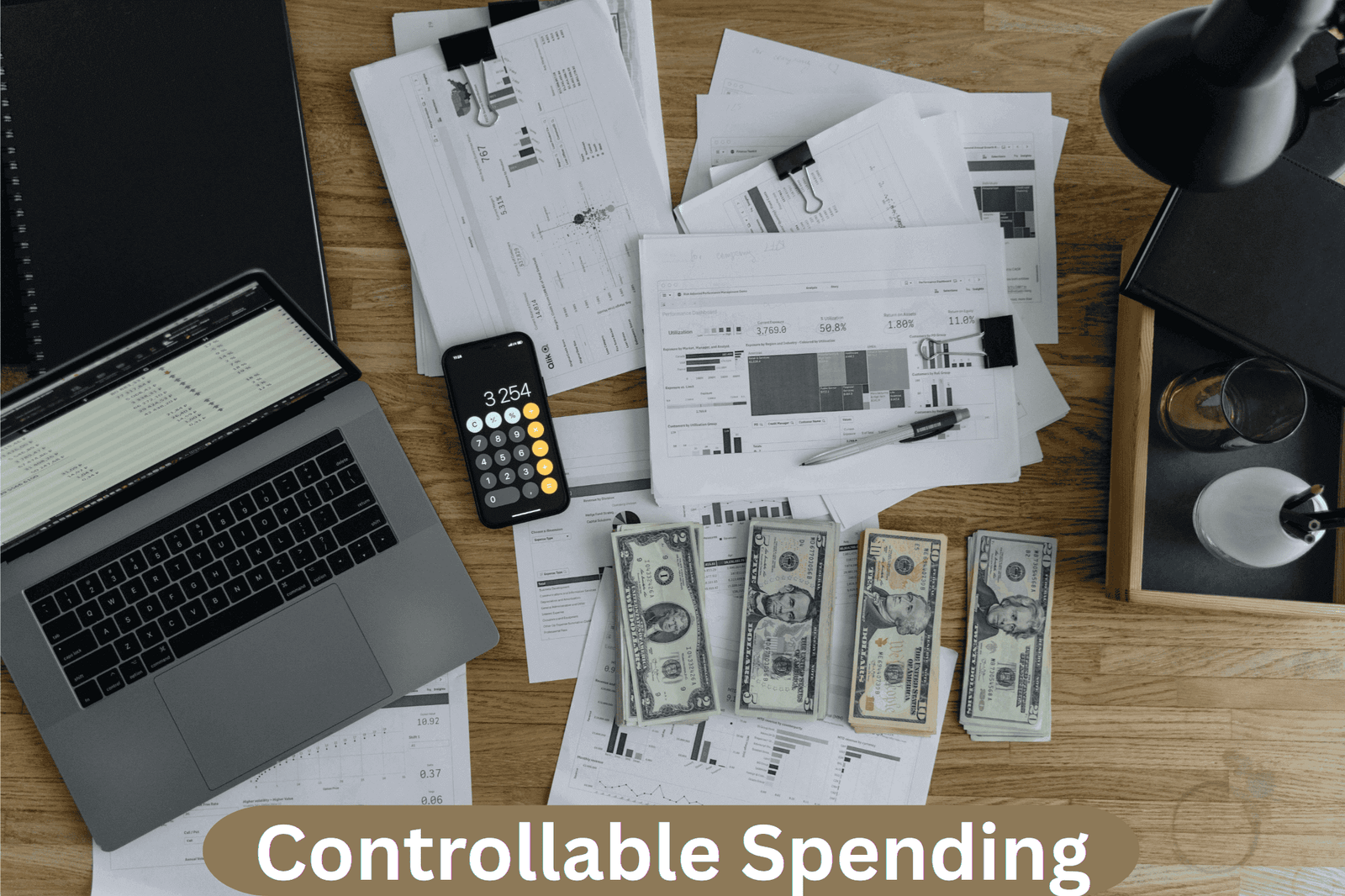Table of Contents
Teens often find themselves with limited funds but plenty of desires—whether it’s the latest gaming console, that concert ticket, or trendy new clothes. But here’s the kicker: how do you get everything you want without burning through your savings? The key lies in controllable spending—the art of prioritizing what really matters while saving for the future. Let’s dive in.
According to National Financial Educators Council, 63% of high school students report having little or no knowledge about personal finance, which is why mastering spending habits early can set the stage for future financial success
What are Controllable Costs
Controllable spending refers to expenses that can be altered in the short term. These costs are within the person or individual’s control, allowing them to decide whether to incur them or not. For example, a department manager may choose to reduce spending on nonessential items, thus making certain expenditures controllable. On the other hand, if these decisions are made by a group or imposed by a third party, such as taxes, the spending becomes uncontrollable from the perspective of a single person.
In many organizations, controllable expenses are more easily handled at higher levels, like a vice president deciding on large budget allocations for employee training. At a low level, such as for frontline managers, decisions on these costs may not be authorized, leading to uncontrollable spending. However, the flexibility to adjust spending based on organizational needs remains a key factor for success in managing finances.
Quick Answer
When it comes to controllable spending, there are certain costs that a manager can directly influence. These include direct materials, direct labor, indirect materials, and indirect labor (such as supervision). These costs can be adjusted or controlled based on the needs of the production process. However, other expenses like depreciation, insurance, allocated repairs, maintenance, and allocated rent or utilities expense are uncontrollable. These costs cannot be influenced by the production manager.
In responsibility accounting, managers are typically evaluated based on the costs they can control. As a result, uncontrollable costs are ignored when assessing the performance of managers. This ensures that managers are only judged on the areas they can influence, making evaluations more fair and aligned with their responsibilities.
Controllable Costs vs. Fixed Costs
Controllable costs are expenses that can be easily altered in the short term, allowing managers to make decisions about whether to incur them or not. These costs are typically more flexible and vary depending on the organization’s needs. For example, if an organization wants to cut down on certain activities, it can reduce controllable costs like advertising or training. However, fixed costs such as rent and insurance cannot be adjusted quickly. These costs usually involve long-term commitments and are paid on a regular basis, regardless of the level of activity.
The key differences between controllable and fixed costs include:
- Controllable costs can be adjusted by management in the short term, whereas fixed costs cannot.
- Controllable costs are influenced by activity levels, but fixed costs remain steady regardless of activity.
- The responsibility for controllable costs typically lies with mid-level managers, while fixed costs are managed at higher levels in the organizational structure.
- Controllable costs are highly flexible, while fixed costs are only flexible over a long period.
According to NerdWallet, Americans spend an average of $218 per month on entertainment subscriptions alone. That’s a good chunk of change that you need to track, even if it’s not immediately changeable
Examples of Controllable Costs
Controllable costs are expenses a business can adjust quickly, especially in response to financial pressures. Some examples include:
- Advertising: It can often be stopped in the short term without hurting sales too much, though it’s necessary in the long term to maintain brand awareness.
- Bonuses: These can be curtailed or delayed, particularly if tied to poor performance and when the cash balance is low.
- Donations: A very controllable expense that can be easily reduced with no significant impact on the business.
- Dues and subscriptions: Can be cut back without affecting company operations.
- Employee compensation: One of the largest controllable costs, especially for support staff not directly involved in sales generation.
- Office supplies: Can be controlled, although it varies with the level of administrative staffing.
- Training: Can be curtailed to save costs, though this may lower employee expertise.
If you’re ready to take control of your money, start with the basics and learn how to budget as a student. Knowing your first priority in a budget ensures every dollar is working toward your goals—from everyday needs to bigger dreams.
Uncontrollable Costs
Uncontrollable costs are expenses that a specified manager cannot control or influence. These costs are typically imposed by top management or are allocated to different departments within an organization. For example, a company-wide advertising cost that is assigned by the central office to various departments is not under the control of the individual department heads. Other uncontrollable costs include expenses like depreciation, insurance, and the share of rent or organization-wide security costs.
These types of costs are often necessary for the business’s operations but cannot be altered by a single department or manager. They are typically tied to overarching decisions made at the management level, affecting the entire company’s finances.

Example of Uncontrollable Spending
When evaluating uncontrollable spending, some costs are typically fixed and not easily altered by the department or managers. These include:
- Direct materials and direct labor: Essential costs tied to the production process.
- Factory overhead and charges: Significant but determined by the larger organizational setup.
- Indirect materials and indirect labor (such as supervision): Not easily adjustable by individual managers.
- Depreciation and insurance: Fixed costs are often part of long-term agreements or organizational policies.
- Allocated repairs, maintenance, allocated rent, and utilities expense: Shared across departments and decided at higher levels in the organization.
To level up your skills, check out practical budgeting tips for young families, dive into 30 real budgeting examples for high school students, and learn how to avoid common budgeting mistakes that could slow down your progress.
Key Takeaways
Controllable costs are expenses that can be managed by a manager or head of a department. These costs are within their control and can be adjusted according to the needs of the business. On the other hand, non-controllable costs are those that are outside the manager’s influence, such as shared expenses like tax, insurance, and building depreciation.
Identifying the difference between these two types of costs requires a clear understanding of authorities and responsibilities within the organization. Recognizing which costs fall under a manager’s control and which do not helps in making more effective financial decisions.
Ready to make saving a habit, not a hassle? Start by exploring smart tips on the psychology of saving money, get simple steps on how to save up for a car, and find fun ideas on things teens can save for. Your future self will thank you.
Frequently Asked Questions
What is an example of a controllable cost?
Controllable costs are expenses that can be influenced or regulated by the manager. Examples include direct materials, direct labor, and certain factory overhead costs, all of which can be controlled by the production manager based on production needs.
What is controllable vs. non-controllable spend?
Controllable costs are expenses that an executive, manager, or department can control or change. For instance, a manager can adjust the budget for various activities. Uncontrollable costs, however, cannot be influenced or altered by the executive, manager, or department and are typically fixed or imposed by higher management.
Fresh money guides you’ll love
Slash months off your auto loan with smart payment hacks.
Read nowYes, it’s possible: rent and still build your home fund.
Read nowStart early, save smart, and unlock your first place.
Read nowTurn the dream trip into a reality with fun saving tricks.
Read nowDisclaimer: The information provided in this post is for general informational purposes only. While every effort has been made to ensure the accuracy of the content, it is not intended as financial or professional advice. Please consult a qualified professional for specific guidance tailored to your situation.

